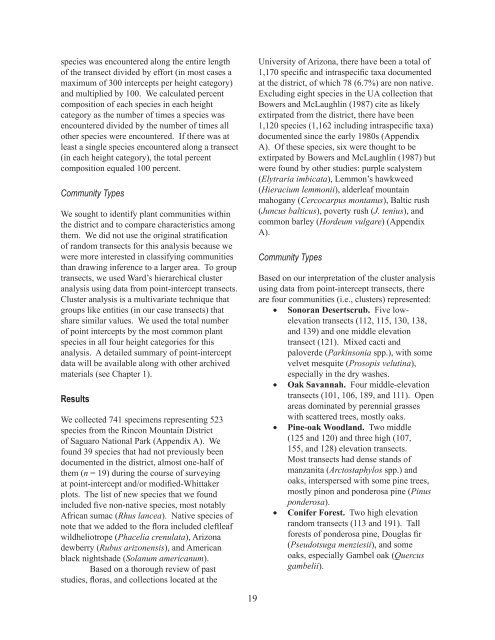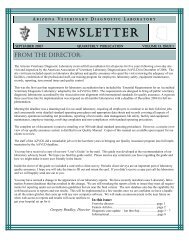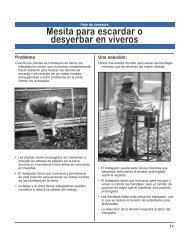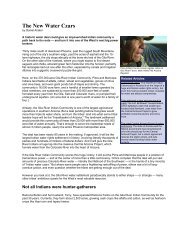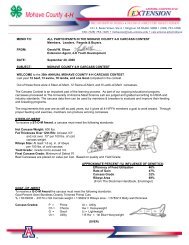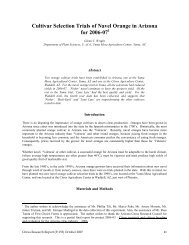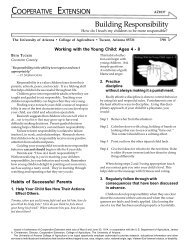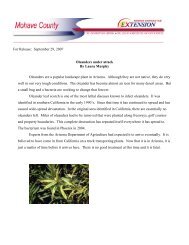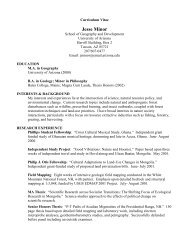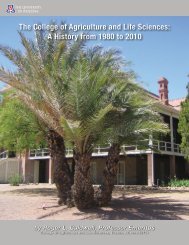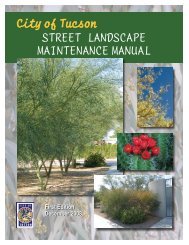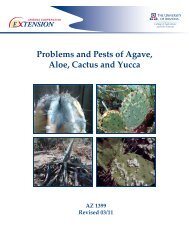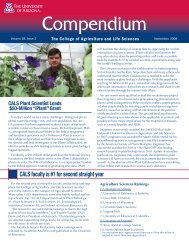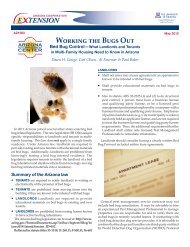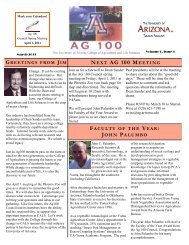Details - CALS Networking Lab - University of Arizona
Details - CALS Networking Lab - University of Arizona
Details - CALS Networking Lab - University of Arizona
Create successful ePaper yourself
Turn your PDF publications into a flip-book with our unique Google optimized e-Paper software.
species was encountered along the entire length<br />
<strong>of</strong> the transect divided by effort (in most cases a<br />
maximum <strong>of</strong> 300 intercepts per height category)<br />
and multiplied by 100. We calculated percent<br />
composition <strong>of</strong> each species in each height<br />
category as the number <strong>of</strong> times a species was<br />
encountered divided by the number <strong>of</strong> times all<br />
other species were encountered. If there was at<br />
least a single species encountered along a transect<br />
(in each height category), the total percent<br />
composition equaled 100 percent.<br />
Community Types<br />
We sought to identify plant communities within<br />
the district and to compare characteristics among<br />
them. We did not use the original stratification<br />
<strong>of</strong> random transects for this analysis because we<br />
were more interested in classifying communities<br />
than drawing inference to a larger area. To group<br />
transects, we used Ward’s hierarchical cluster<br />
analysis using data from point-intercept transects.<br />
Cluster analysis is a multivariate technique that<br />
groups like entities (in our case transects) that<br />
share similar values. We used the total number<br />
<strong>of</strong> point intercepts by the most common plant<br />
species in all four height categories for this<br />
analysis. A detailed summary <strong>of</strong> point-intercept<br />
data will be available along with other archived<br />
materials (see Chapter 1).<br />
Results<br />
We collected 741 specimens representing 523<br />
species from the Rincon Mountain District<br />
<strong>of</strong> Saguaro National Park (Appendix A). We<br />
found 39 species that had not previously been<br />
documented in the district, almost one-half <strong>of</strong><br />
them (n = 19) during the course <strong>of</strong> surveying<br />
at point-intercept and/or modified-Whittaker<br />
plots. The list <strong>of</strong> new species that we found<br />
included five non-native species, most notably<br />
African sumac (Rhus lancea). Native species <strong>of</strong><br />
note that we added to the flora included cleftleaf<br />
wildheliotrope (Phacelia crenulata), <strong>Arizona</strong><br />
dewberry (Rubus arizonensis), and American<br />
black nightshade (Solanum americanum).<br />
Based on a thorough review <strong>of</strong> past<br />
studies, floras, and collections located at the<br />
19<br />
<strong>University</strong> <strong>of</strong> <strong>Arizona</strong>, there have been a total <strong>of</strong><br />
1,170 specific and intraspecific taxa documented<br />
at the district, <strong>of</strong> which 78 (6.7%) are non native.<br />
Excluding eight species in the UA collection that<br />
Bowers and McLaughlin (1987) cite as likely<br />
extirpated from the district, there have been<br />
1,120 species (1,162 including intraspecific taxa)<br />
documented since the early 1980s (Appendix<br />
A). Of these species, six were thought to be<br />
extirpated by Bowers and McLaughlin (1987) but<br />
were found by other studies: purple scalystem<br />
(Elytraria imbicata), Lemmon’s hawkweed<br />
(Hieracium lemmonii), alderleaf mountain<br />
mahogany (Cercocarpus montanus), Baltic rush<br />
(Juncus balticus), poverty rush (J. tenius), and<br />
common barley (Hordeum vulgare) (Appendix<br />
A).<br />
Community Types<br />
Based on our interpretation <strong>of</strong> the cluster analysis<br />
using data from point-intercept transects, there<br />
are four communities (i.e., clusters) represented:<br />
• Sonoran Desertscrub. Five lowelevation<br />
transects (112, 115, 130, 138,<br />
and 139) and one middle elevation<br />
transect (121). Mixed cacti and<br />
paloverde (Parkinsonia spp.), with some<br />
velvet mesquite (Prosopis velutina),<br />
especially in the dry washes.<br />
• Oak Savannah. Four middle-elevation<br />
transects (101, 106, 189, and 111). Open<br />
areas dominated by perennial grasses<br />
with scattered trees, mostly oaks.<br />
• Pine-oak Woodland. Two middle<br />
(125 and 120) and three high (107,<br />
155, and 128) elevation transects.<br />
Most transects had dense stands <strong>of</strong><br />
manzanita (Arctostaphylos spp.) and<br />
oaks, interspersed with some pine trees,<br />
mostly pinon and ponderosa pine (Pinus<br />
ponderosa).<br />
• Conifer Forest. Two high elevation<br />
random transects (113 and 191). Tall<br />
forests <strong>of</strong> ponderosa pine, Douglas fir<br />
(Pseudotsuga menziesii), and some<br />
oaks, especially Gambel oak (Quercus<br />
gambelii).


